IGHG1
-
Official Full Name
immunoglobulin heavy constant gamma 1 (G1m marker)
-
Overview
Human IgG consists of four subclasses (1-4) that can be recognised by antigen differences in their heavy chains. Each subclass has different biological and physiochemical properties. The IgG subclass may be preferentially produced in response to different antigens. The Fab fragment (fragment antigen binding) is the antigen region of the IgG molecule. It is composed of one constant and one variable domain of each of the heavy and the light chain. -
Synonyms
IgG1; Igh-4; VH7183; Ighg1; IgG1 (Fc);
- Recombinant Proteins
- Cell & Tissue Lysates
- Protein Pre-coupled Magnetic Beads
- Antibody
- Native Proteins
- Human
- Mouse
- CHO
- E.coli
- HEK293
- HEK293 cells
- Human Cell
- Human Plasma
- Mammalian cells
- Mouse
- Porcine Serum
- Rabbit
- Avi
- Fc
- His
- His (Fc)
- His|Avi
- His|SUMO
- SUMO
- HRP
- N/A
- Non
- Tagged
- Tag Free
- Background
- Quality Guarantee
- Case Study
- IGHG1 Related Articles

Fig1. The typical numbers of functional gene segments are shown. (Harry W Schroeder Jr, 2010)
What is IGHG1 protein?
IGHG1 (immunoglobulin heavy constant gamma 1 (G1m marker)) gene is situated on the long arm of chromosome 14 at locus 14q32. Human IgG consists of four subclasses (1-4) that can be recognised by antigen differences in their heavy chains. Each subclass has different biological and physiochemical properties. The IgG subclass may be preferentially produced in response to different antigens. The Fab fragment (fragment antigen binding) is the antigen region of the IgG molecule. It is composed of one constant and one variable domain of each of the heavy and the light chain. The IGHG1 protein is consisted of 399 amino acids and its molecular mass is approximately 43.9 kDa.
What is the function of IGHG1 protein?
Immunoglobulins, also known as antibodies, are membrane-bound or secreted glycoproteins produced by B lymphocytes. In the recognition phase of humoral immunity, the membrane-bound immunoglobulins serve as receptors which, upon binding of a specific antigen, trigger the clonal expansion and differentiation of B lymphocytes into immunoglobulins-secreting plasma cells. Secreted immunoglobulins mediate the effector phase of humoral immunity, which results in the elimination of bound antigens The antigen binding site is formed by the variable domain of one heavy chain, together with that of its associated light chain. Thus, each immunoglobulin has two antigen binding sites with remarkable affinity for a particular antigen.
IGHG1 Related Signaling Pathway
IGHG1 protein is an immunoglobulin, mainly involved in humoral immune response. When it binds to the antigen, it can activate the complement system, trigger an inflammatory response, and promote the proliferation and differentiation of B cells. In addition, IGHG1 is also involved in the occurrence and development of autoimmune diseases.
In addition to humoral immune response, IGHG1 may also be involved in the regulation of other signaling pathways. For example, it can bind to receptors on the cell surface and activate downstream signaling pathways, thereby affecting biological behaviors such as cell growth, differentiation, and migration. In addition, IGHG1 may also be involved in the regulation of apoptosis, angiogenesis and other processes.
IGHG1 Related Diseases
The abnormality of IGHG1 protein may lead to the occurrence of a variety of immune-related diseases, including chronic inflammation and inflammatory diseases, such as rheumatoid arthritis and inflammatory bowel disease. Allergic diseases such as allergic rhinitis, bronchial asthma and autoimmune diseases.
Bioapplications of IGHG1
IGHG1 protein can be used in biosensors, immunostaining and other medical devices for further clinical treatment or scientific research. Or part of the antibody is used to make monoclonal antibodies to treat certain types of cancer and autoimmune diseases.
High Purity
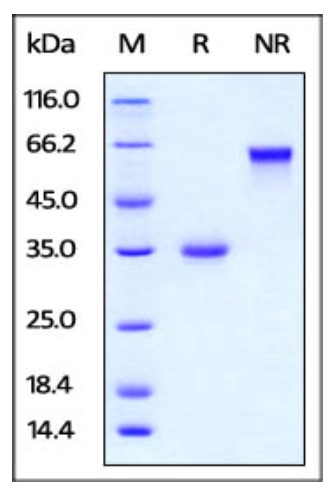
Fig1. SDS-PAGE (IGHG1-372H) (PROTOCOL for western blot)
.
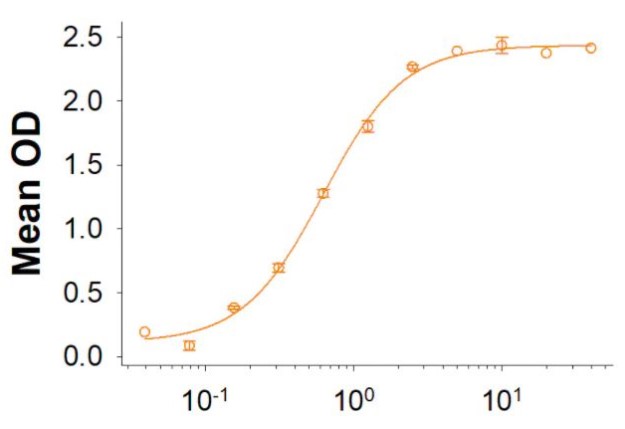
Fig2. Activity Data. (IGHG1-051H)
Case study 1: Yongmei Jin, 2023
This study researched the exact function of IgG1 heavy chain (IGHG1) on breast cancer (BC) progression. IGHG1 level within BC and paired normal tissues was acquired in Gene Expression Profiling Interactive Analysis dataset. Meanwhile, this work harvested tumor and paired healthy tissues in 42 BC cases. siRNA targeting IGHG1 was transfected into BC cells. SC79 was used to treat the transfected BC cells. CCK-8 assay, clone formation experiment, BrdU assay, Transwell experiment and flow cytometry were carried out to measure the viability, colony formation, proliferation, invasion, and apoptosis of BC cells. Paclitaxel and cisplatin sensitivity of BC cells was evaluated by MTT assay. Real-time quantitative reverse transcription-polymerase chain reaction and Western-blot were performed for measuring mRNA and protein expression.
The overexpressed IGHG1 indicated dismal BC survival. IGHG1 silencing attenuated the viability, invasion, proliferation, epithelial-mesenchymal transition, but enhanced the apoptosis of BC cells. IGHG1 silencing enhanced the paclitaxel and cisplatin sensitivity of BC cells. IGHG1 silencing suppressed the activity of the MEK, AKT, and ERK pathways. AKT agonist partially reversed the inhibition of IGHG1 silencing on BC cell malignant phenotype and resistance to paclitaxel and cisplatin. IGHG1 promotes the malignant development of BC by activating the AKT pathway.
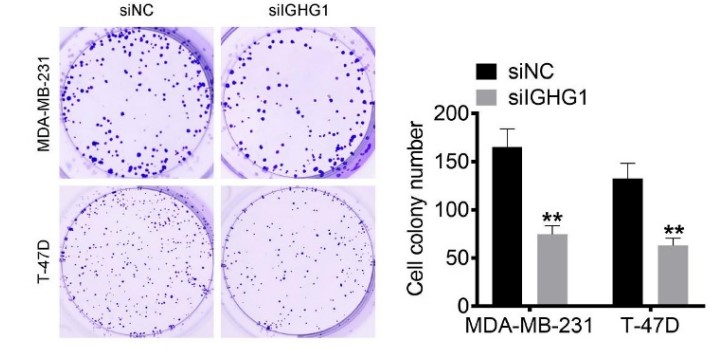
Fig1. Clone formation experiment revealed that IGHG1 silencing markedly reduced T-47D and MDA-MB-231 cell proliferation.
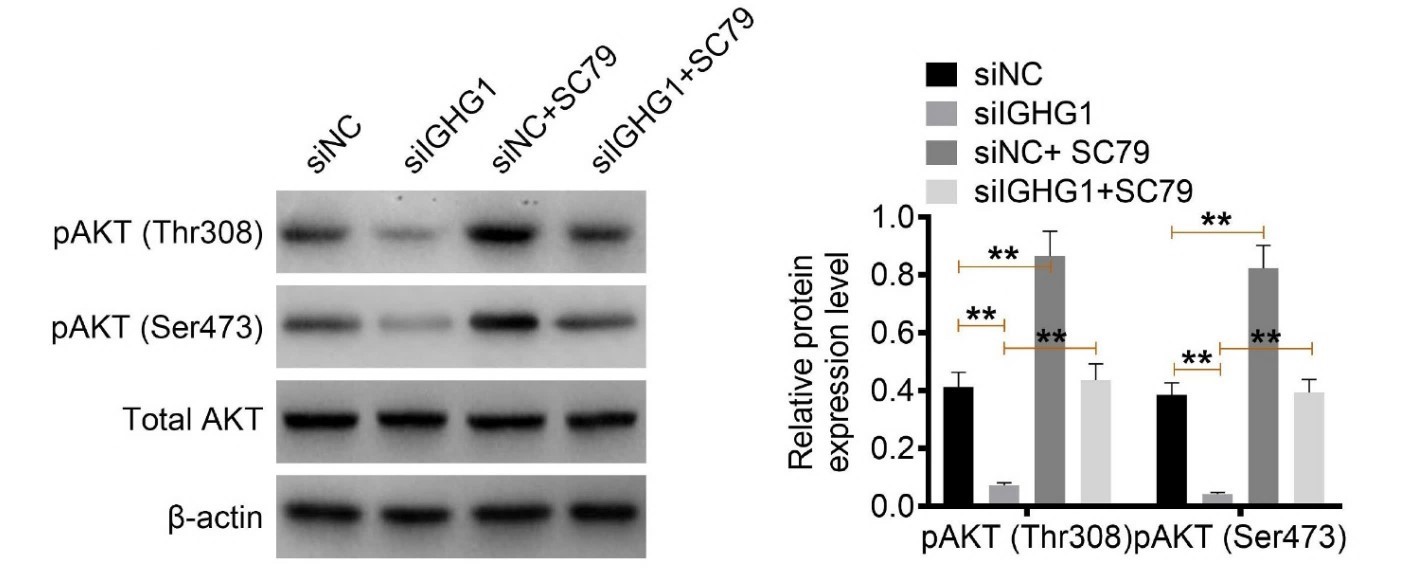
Case study 2: Jing Chu, 2019
Increasing evidence indicates that immunoglobulins are important for the regulation of various cancers including prostate cancer (PCa). However, the underlying mechanisms of IgG regulated PCa development remain to be further explored. Here, the researchers demonstrated that IgG1 heavy chain (IGHG1) was increased in tissues from PCa patients. Inhibition of IGHG1 by antibody blocking or genetic knockdown suppressed cell growth and induced cell cycle arrest and ultimate apoptosis. Expression levels of c-Myc were positively correlated with the levels of IGHG1. Furthermore, MEK/ERK/c-Myc pathway lied downstream of IGHG1 in cultured prostate cancer cells. Inhibition of IGHG1 restrained the tumor growth in nude mice and inactivated MEK/ERK/c-Myc pathway both in vitro and in vivo.
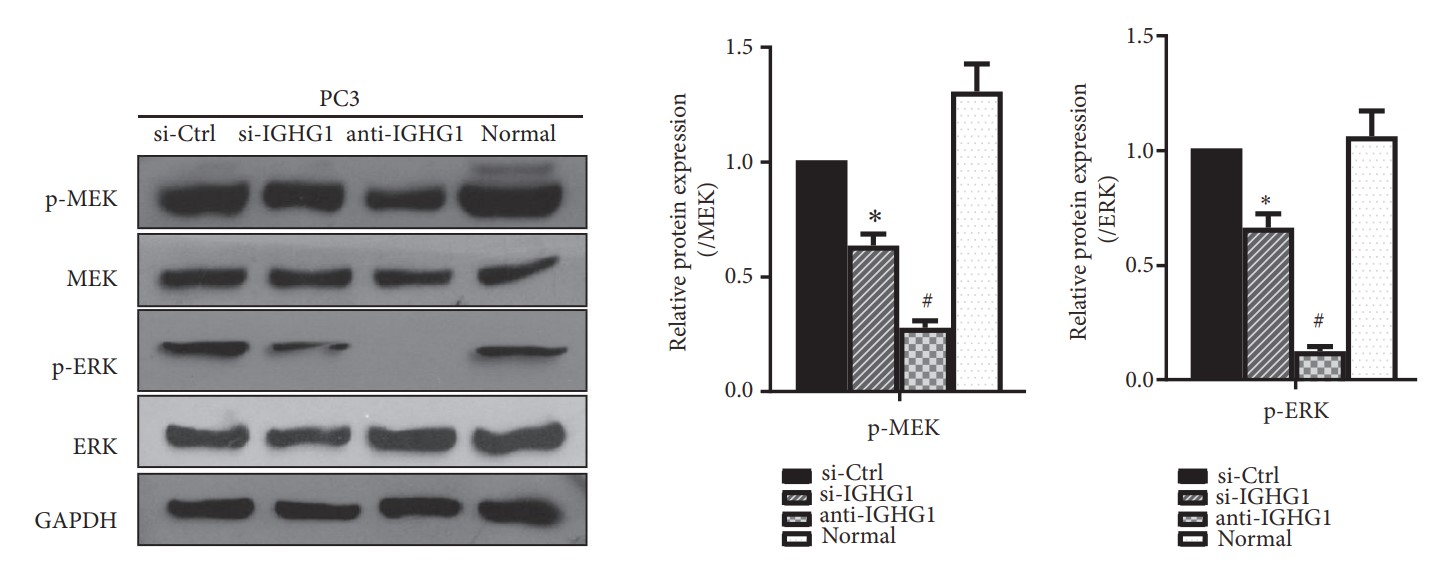
Fig3. IGHG1 regulates PCa cell growth via MEK/ERK/c-Myc pathway. The statistical data of p-MEK (comparing to total MEK) and p-ERK (comparing to total ERK) were shown.
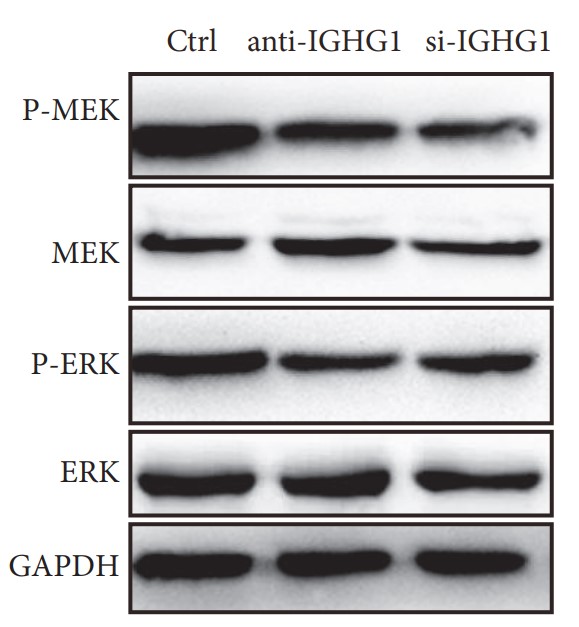
IGHG1 involved in several pathways and played different roles in them. We selected most pathways IGHG1 participated on our site, such as , which may be useful for your reference. Also, other proteins which involved in the same pathway with IGHG1 were listed below. Creative BioMart supplied nearly all the proteins listed, you can search them on our site.
| Pathway Name | Pathway Related Protein |
|---|
IGHG1 has several biochemical functions, for example, . Some of the functions are cooperated with other proteins, some of the functions could acted by IGHG1 itself. We selected most functions IGHG1 had, and list some proteins which have the same functions with IGHG1. You can find most of the proteins on our site.
| Function | Related Protein |
|---|
IGHG1 has direct interactions with proteins and molecules. Those interactions were detected by several methods such as yeast two hybrid, co-IP, pull-down and so on. We selected proteins and molecules interacted with IGHG1 here. Most of them are supplied by our site. Hope this information will be useful for your research of IGHG1.
- Q&As
- Reviews
Q&As (6)
Ask a questionYes, IGHG1 protein regulates the activity and function of immune cells by interacting with their receptors.
IGHG1 protein is expressed at abnormal levels in some immune diseases and can be detected as one of the markers of diseases, such as rheumatoid arthritis.
IGHG1 protein is involved in humoral immunity, protecting the body from infection by interacting with pathogens, neutralizing toxins, and assisting in the phagocytosis of immune cells.
Yes, there may be a correlation between IGHG1 protein and response to immunotherapy, and researchers are exploring it as a predictor of immunotherapy.
Yes, the IGHG1 protein is an important component involved in antibody-dependent cytotoxicity (ADCC) and enhances cytotoxicity by interacting with effector cells.
Yes, some studies have found that the expression level of IGHG1 protein is related to the severity of immune diseases, which may be one of the indicators to evaluate disease progression and prognosis.
Customer Reviews (3)
Write a reviewGood stability, suitable for long-term storage.
It can induce specific immune response accurately and stably, which is of great application value.
Fluorescent labeling works very well, it helps with imaging studies, it works very well.
Ask a Question for All IGHG1 Products
Required fields are marked with *
My Review for All IGHG1 Products
Required fields are marked with *


